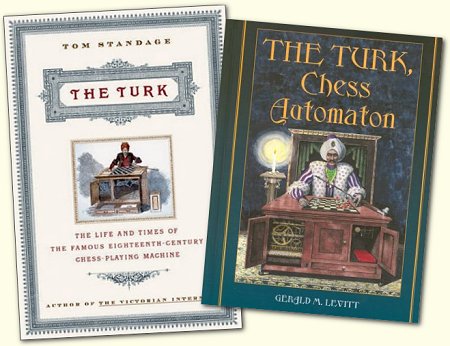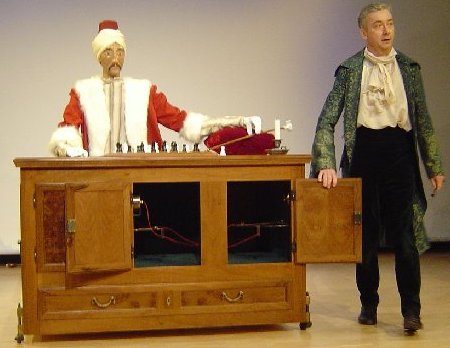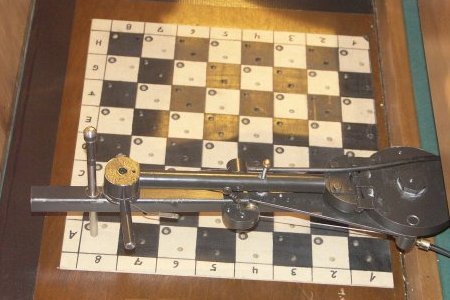You probably know all about the "Turk", the first chess machine,
presented in 1769 by the Hungarian engineer Baron Wolfgang von Kempelen. The
story has been retold countless times, a slew of books has appeared on the
subject. Here are two recent publications:

- Tom
Standage: The Turk – The Life and Times of the Famous Eighteenth-Century
Chess-Playing Machine. Hardcover: 224 pages, Walker & Co; April 2002,
ISBN: 0802713912. $24.00.
- Gerald M
Levitt: The Turk, Chess Automaton, McFarland, $50.00, 268 pages, hardback;
2000.
- Tom Standage:
The Mechanical Turk (eBook). Publisher: ePenguin, May 2002, 280 pages,
ISBN: 0141885300.
ChessBase articles:
- The first
chess machine
- History of
computer chess
- Edgar Alan
Poe: Maelzel's Chess-Player
For those of you who know nothing about the Turk here's a short introduction
from Tom Standage's book
(also available in eBook form):
On an autumn day in 1769, Wolfgang von Kempelen, a thirty-five-year-old
Hungarian civil servant, was summoned to the imperial court in Vienna by
Maria Theresa, empress of Austria-Hungary. The meeting set in motion a chain
of events that led him to construct an extraordinary machine: a mechanical
man, dressed in an oriental costume, seated behind a wooden cabinet, and
capable of playing chess.

At the time, elaborate mechanical toys were a popular form of entertainment
in the courts of Europe. Kempelen intended his chess-playing machine to do
little more than amuse the court and advance his career by impressing the
empress. But instead his automaton unexpectedly went on to achieve widespread
fame throughout Europe and America, bringing Kempelen both triumph and despair.
During its eighty-five-year career the automaton was associated with a host
of historical figures, including Benjamin Franklin, Catherine the Great,
Napoleon Bonaparte, Charles Babbage, and Edgar Allan Poe. It was the subject
of numerous stories and anecdotes and inspired many legends and outright
fabrications. The chess player was, in fact, destined to become the most
famous automaton in history.


To modern eyes, in an era when it takes a supercomputer to defeat the world
chess champion, it seems obvious that Kempelen’s chess-playing machine
had to have been a hoax—not a true automaton at all but a contraption
acting under the surreptitious control of a human operator, like a puppet
dancing on a string.

Even among the skeptics who insisted it was a trick, there was disagreement
about how the automaton worked, leading to a series of claims and counterclaims.
Did it rely on mechanical trickery, magnetism, or sleight of hand? Was there
a dwarf, or a small child, or a legless man hidden inside it? Was it controlled
by a remote operator in another room or concealed under the floor? None of
the many explanations put forward over the years succeeded in fully fathoming
Kempelen’s secret and served only to undermine each other. Indeed,
it is only recently, following the construction of a replica of the automaton,
that the full secret of its operation has been uncovered.
 The
Turk in Paderborn
The
Turk in Paderborn
Wolfgang von Kempelen died 200 years ago. To commemorate this anniversary
the Heinz Nixdorf Museum in Paderborn has produced a working replica of the
famous chess Turk. Hundreds of visitors gathered there on the presentation
day to relive a scene that duplicated what the audiences had witnessed in Maria
Theresia's day. Mathias Feist and Karsten Bauermeister were at the event and
sent us pictures and impressions.

An introductory lecture by Prof. Ernst Strouhal on the Turk held the audience
spell-bound

The modern-day recontruction of the Turk is wheeled in. An actor takes over
the role of Wolfgang von Kempelen to demonstrate the operation of the machine.

First he opens the two compartments to show that they arequite empty.

Then he opens the leftmost door to reveal...

... nothing but a mass of cog-wheels, shafts and levers

The maestro closes the doors and "winds up" the machine

... which then starts to play chess!

The figure is obviously artificial and cannot conceal a human being

And yet it executes chess moves, with mechanical precision.

Afterwards the secrets of the machine are revealed

This is Achim Schwarzmann who was hidden in the cabinet

The board attached to the cieling of the compartment where the human operator
follows the moves played above

A "pentograph" with which the Turk's arms are moved

A picture of the Turk in an earlier contrcution phase.
Link























 The
Turk in Paderborn
The
Turk in Paderborn


















